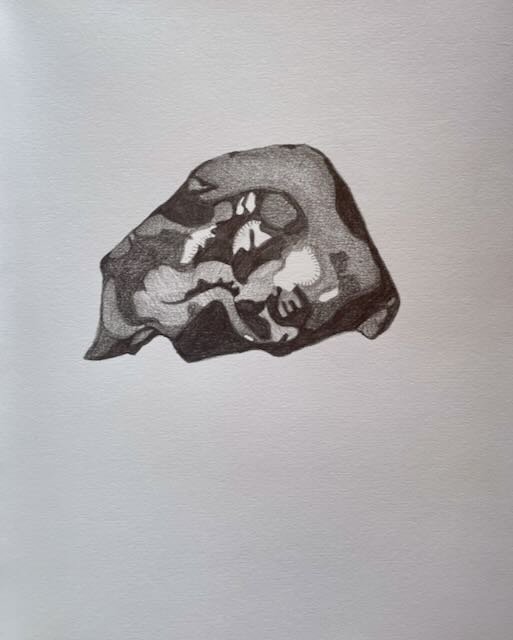rESIDENCY: Raglan, NZ
22 January - 1 February 2025
Tracing the Stones
The Sea and the Stones
… in their resting place
Raglan is characterised by a coastline that is renowned in the surfing community for its exceptional left hand break. My initial focus during this residency was to place myself by the sea and observe the famous waves of Manu and Whale Bay. I took my camera and sound recorder with me but apart from that had no particular agenda. I wanted to be open to what was present and happening. What became evident, along with the dramatic wild sea and black sand, was the vast presence of volcanic rock.
In their resting place (for now) on the black sand, pushed and pulled from all and every direction, the basalt stones illustrate steadfastness in spite of the shifting sands and battering waves. A volcanic eruption on Mt Karioi, 2.5 million years ago, was where and when these stones began their journey. Expelled from the mountain, tumbling down towards the coast, they settled at a place where the land meets the sea.
One stone, captured in the film below, is centrally placed, and does not move. Any alteration or changes in the film come from the waves or the sway of the film maker. Three parts of a trilogy, rock, sea and observer, render the content of this short film, the object, the context and evidence of time. Behind the camera, unseen, the observer stands apart, identifiable only by the shake of the recording. They (namely me) are merely framing a moment in time in order that the object and context be captured and defined. The rock and the sea did not need the film to confirm the phenomenon of their existence, but for the film maker it was crucial. It directed focus in a landscape too full of meaning and helped to channel a response that was grounding and purposeful.
Stones I-IV (2025), pencil on paper, 24.9 x 18.8 cm each
The Gorge and the Stones
… tumbling towards the sea
Te Toto Gorge
As my focus on the basalt stones increased, I began to take an interest in where the stones came from and how they shaped the landscape after the volcanic eruption 2.5 million years ago. Te Toto Gorge, a geographical scar that extends from the now extinct volcano to the sea, emerged as a place of interest. It was formed when a side flank of the volcano collapsed, exposing balsaltic lava embedded in the cliffs and revealed clear geological characteristics, unique to Mt Karioi.
A walking track from the road above granted entry and provided passage deep into the gorge. My descent on the 28th January followed a marked trail that was difficult to trace, and very steep and slippery in places. It was like walking through earths deep history. I noticed the balsalt stones and listened to the sounds of the trickling stream. I was able to experience the sensation of emersion as I entered the thick undergrowth that characterised the beginning of the trail. Once deep inside the gorge and through the thicket, the enormity of the amphitheatre created by Te Toto Gorge was something to behold. Looking up towards the gorge and away from the sea, Mt Karioi loomed above.
The Volcano and the Stones
… the source
Mt Karioi from my residence
It was inevitable that the next stage of my residency was to climb Mt Karioi. On the 3rd of February, with my sister Jo, I set out to experience the volcano first hand, which had until then, been a formidable and foreboding presence in the landscape.
My journey began in the present, on the beach in Raglan, and travelled back in time through the gorge, leaving the quest to climb Mt Karioi to last. I began to get a sense of the force of nature as it laid down its present form. To reach the summit, (in fact we didn’t continue to the summit but were satisfied with reaching the ‘Lookout’ of Mt Karioi), we climbed steadily for 2 hours. There were challenging moments but it was manageable and we completed the climb there and back in a day. At times it was necessary to navigate ladders and chains to help with the steep sections of the mountain. I felt a deep sense of accomplishment, and for a period of time, was able to experience the mountain’s earthiness, steepness, sounds and vegetation. Less tangible but equally present, was the perception of immensity and mysteriousness.
I have yet to realise how the experience of my residency in Raglan manifests back in my studio in the UK. At the moment it is a story of a journey back in time but also a journey in the present. It began with a stone in the sea, the sound of waves and the shifting sand. It also began with a singular observer, the film maker, the person behind the camera, being, resident, in a select place at a specified time.















